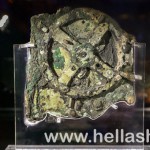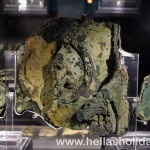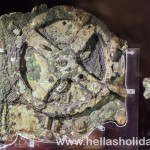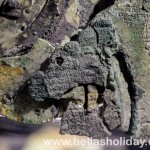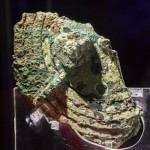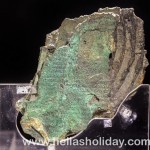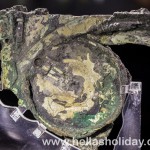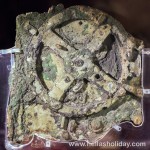 The Shipwreck of Antikythera (Greek: Ναυάγιο των Αντικυθήρων), which is estimated to have happened between the 70–50 BC, was hiding a remarkable treasure. Until today, more than 300 items of great archaeological value, dating from the fourth until the first century BC, have been retrieved from the shipwreck and more may be rescued in the near future by ongoing expeditions in the area. This article is about the Antikythera Mechanism (Greek: Μηχανισμός των Αντικυθήρων) only, but you can read more about the Antikythera Shipwreck and the Treasures it held in one of my previous articles.
The Shipwreck of Antikythera (Greek: Ναυάγιο των Αντικυθήρων), which is estimated to have happened between the 70–50 BC, was hiding a remarkable treasure. Until today, more than 300 items of great archaeological value, dating from the fourth until the first century BC, have been retrieved from the shipwreck and more may be rescued in the near future by ongoing expeditions in the area. This article is about the Antikythera Mechanism (Greek: Μηχανισμός των Αντικυθήρων) only, but you can read more about the Antikythera Shipwreck and the Treasures it held in one of my previous articles.
When sponge divers from the island of Symi discovered, in 1900, the ancient shipwreck just off the Greek island of Antikythera, among the several findings that they retrieved from the location of the shipwreck, there was one thing that triggered their —and later on the archaeologists’— curiosity; the fragments of a small metallic construction bearing a number of gear wheels.
Decoding the function of the Antikythera Mechanism
A group of experts, including archaeologists, mathematicians, physicists and engineers, worked together to decipher the function of this device, only to discover that the mechanism was far more sophisticated than they had initially thought. Using state-of-the-art imaging techniques they managed to dive into the interior of the mechanism, which was hiding a number of gears and dials; far too many components for just a simple calendar. The decryption of the device’s function took many years and a great deal of team work. Thanks to this intensive study, we now know that this construction, widely known as the “Antikythera Mechanism, was once an amazingly powerful astronomical calculator and it is the most complex device known from antiquity, considered by scientists as “world’s oldest portable computer”. Nevertheless, there are still more functions to be decoded and yet more questions around the mechanism to be answered.
Until today, seven large fragments (named A–G) and 75 minor ones (named 1–75), belonging to the Antikythera Mechanism, have been rescued from the shipwreck. Their exact position in the mechanism and their function are still a matter of intensive ongoing study. What we do know, however, is that the mechanism consisted of a minimum of 30 gears, as well as a number of dials, pointers, axles and scales. The inscriptions, in ancient Greek, carved on the surface of the mechanism are referring to astronomical and calendar calculations, while the inscriptions found on the metallic protective plates of the mechanism are some sort of “user’s manual” with instructions on how to operate the mechanism. It is speculated that the mechanism was encased in a wooden box bearing two bronze plaques; one fixed to the front part of the box and one fixed to its back.
Based on today’s most prevalent theory, the mechanism could show the position of the sun, the moon and most probably the five planets known in antiquity; Mercury, Venus, Mars, Jupiter and Saturn. It could show the lunar phase and predict the dates of solar and lunar eclipses, possibly based on the Babylonian Saros cycle. Its screen represented at least two calendars; a Greek one based on the Metonic cycle (also known as “Enneadecaeteris” from the Ancient Greek “εννεαδεκαετηρίς”, meaning a “nineteen-year period”) and one Egyptian calendar. Based on the parts of the inscriptions that were not damaged through the centuries and were therefore still readable, the mechanism also predicted and displayed the dates for the Pan-Hellenic games that took place in Nemea, the Isthmus of Corinth, Delphi, Dodoni and Olympia.
The construction period of the “Antikythera Mechanism is estimated to be the second half of the second century BC, which indeed makes it the earliest preserved portable astronomical calculator. Its creator is still unknown, but speculations suggest it could be the ingenious Greek mathematician and engineer, Archimedes.
The significance of the Antikythera Mechanism
The Antikythera Mechanism is the perfect proof of the —anyway indisputable— astronomical, mathematical and mechanical ingenuity of ancient Greeks in the Late Hellenistic period. Its discovery and decryption revealed the existence of a very high level of technology in the ancient Greek world. Until recently we thought that this technology was only developed much later. This is one reason why the Antikythera Mechanism has completely changed the way we thought of the ancient world and it has triggered a vivid international scientific discussion about the way and the extent to which the Roman aristocracy and wealthy entrepreneurs of the first century BC were influenced by the Greek lifestyle.
The Antikythera Mechanism is exposed as part of the temporary exhibition: “the Antikythera Shipwreck — the Ship – the Treasures – the Mechanism”, in the National Archaeological Museum of Athens. The exhibition’s duration has now been extended until the 31st of August 2013, so if you visit Greece during the summer, do not miss it! It is absolutely stunning!
If you are interested in getting to know more about the National Archaeological Museum of Athens, such as further information about its collections, permanent and temporary exhibitions, as well as opening hours, you can visit its official website here.
- The Antikythera Mechanism: An overview of major and minor fragments, 2nd century BC
- Antikythera Mechanism Fragments A, B and C side 1
- Antikythera Mechanism Fragments A, B and C side 2
- Antikythera Mechanism Fragment A side 1
- Antikythera Mechanism Fragment A side 2 detail
- Antikythera Mechanism Fragment B side 1
- Antikythera Mechanism Fragment B side 2
- Antikythera Mechanism Fragment C side 1
- Antikythera Mechanism Fragment C side 2
Here is a clip of the presentation of the Antikythera Shipwreck exhibition. The clip is property of the National Archaeological Museum of Athens.
And here you can watch two very good documentaries about the Antikythera Mechanism, one by —and property of— The BBC and a second one by the broadcast “Ancient Discoveries”, property of the History Channel, A&E Television Networks, LLC.


